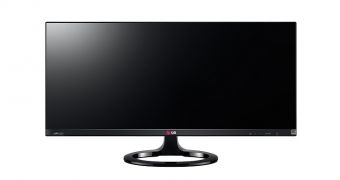They aren't ultra-high definition, but the new monitors from LG Electronics definitely aren't your average, run-off-the mill displays, not with the large difference between horizontal and vertical pixel counts.
The 21:9 aspect ratio might not be known to all that many people, but there isn't much justification for this low level of awareness.
After all, while most films shown in cinemas use the 16:9 aspect ratio (cinematic aspect ratio), the big screens usually come in 21:9 format (ultra-widescreen).
On the LG 29EA73-P and 29EB73-P monitors, the duo that has only just made its debut, 21:9 translates into a native resolution of 2560 x 1080 pixels.
Both of them measure 29 inches in diagonal, but that doesn't mean they have precisely the same size and weight.
The 29EA73-P is a 5.6 kilogram product (13 pounds) that measures 699.7 x 387.0 x 197.2 mm, or 27.54 x 15.23 x 7.75 inches.
Meanwhile, the 29EB73-P weighs 6.9 kilograms (15.21 pounds) and measures 699.7 x 395.3 x 225.0 mm / 27.54 x 15.63 x 8.85 inches.
The 29EA73-P and 29EB73-P are the second and third ultra-widescreen monitors from LG and come with dual-link DVI, DisplayPort and HDMI inputs.
There is one of each of those interfaces, but two HDMI connectors, including one with MHL (mobile high-definition link).
USB 3.0 hubs are integrated into the newcomers as well, along with audio output ports in case the built-in 7W speakers aren't good enough.
Obviously, the 29EB73-P will be a bit more expensive than the other, and should have some extra perks (power efficiency, color sharpening or some other technology). Sadly, the Akihabara News report didn't say much about any environmental friendliness certifications.

 14 DAY TRIAL //
14 DAY TRIAL //